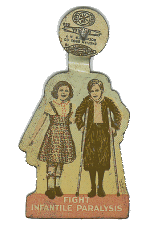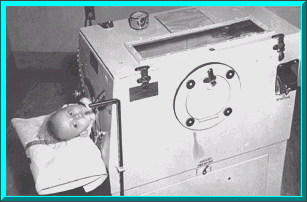









 
|
In the United States, the latter half of the
19th century was characterized by virulent disease. The industrial revolution
brought people crowding into cities. They came from the American farm. They
immigrated from overseas. These cities were not prepared to handle the influx of
residents. Typhus, cholera, scarlet fever, diphtheria, pertussis, and measles
killed tens of thousands of people.
As medical knowledge increased, it became apparent that these diseases
could be controlled in part through sanitation. Huge public works projects were
undertaken to ensure that cities had clean water. For example, in 1885 a
cholera/typhus epidemic killed 90,000 Chicagoans; in 1900, the Chicago River's direction
was reversed, so that the city's sewage was carried to the Mississippi instead of into
Lake Michigan and the city's water supply.1 Projects like
this slowed the spread of these diseases.
Then, quite suddenly, a new disease appeared. It seemed to come out
of nowhere. It started out like a cold, with a mild fever. Some people never
got any sicker. Some people woke up one morning unable to move. Some were
suddenly unable to breathe. Some died. Of those who recovered, some recovered
completely. Some were permanently paralyzed. The affected limbs were not just
impotent; they twisted in on themselves, horribly deforming the victims. People
lived in fear of this new crippler/killer they called infantile paralysis.
From 1916 until 1954, there was at least one polio epidemic every summer
somewhere in the U.S.2 Epidemics meant thousands, tens of
thousands, of children ill, in hospital. While ill, children were paralyzed.
They could not move, many could not even breathe. They were confined to iron
lungs. Air was repeatedly pumped into and sucked from the sealed chambers in which
their bodies lay; the pressure caused their lungs to inflate and deflate. The
hissing and thudding of the machine would be a counterpoint for their lives for months or
years. Row upon row of children were laid out like cordwood in newly constructed
polio respiratory wards, or in field hospitals thrown up to isolate the infected.

Child in an iron lung c. 1930.
Photo courtesy of the March of Dimes
Two generations of Americans lived in terror of the plague that came from
nowhere, felled thousands, had no cure and no treatment, and had a cruelly particular love
for children.
Then, as suddenly as the disease appeared, it was stopped short.
Inspired by the fear this dread disease engendered, empowered by a president who was
himself a victim, and funded by the average American seeking to protect the nation's
children, scientists searched for a cure. What they found was a preventive, a
vaccine. The Salk vaccine was the first weapon against polio. It turned the
tide, and ended the terror.


Footnotes
1. "The Chicago River." Friends of the
Chicago River. http://www.chicagoriver.org/cr/history.html.
(15 May 1999).
2. Smith, Jane S. Patenting the Sun: Polio and the
Salk Vaccine. New York, New York: William Morrow & Co.
1990. p. 39.

Created by
as a project for
Humanities 410
Contemporary World
Devry Institute of Technology
Pomona, California
Spring 1999
|
